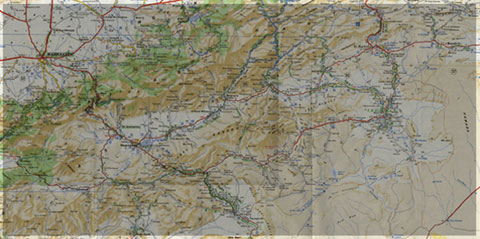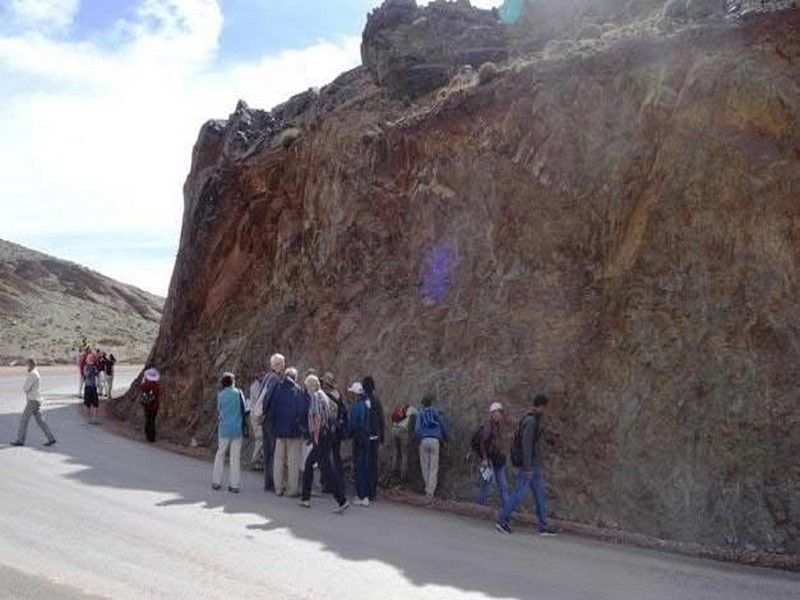Recherchez sur le site !
Recherche avancée / SpécifiqueCatégories publications
+ Sciences De La Terre - Archéologie - Astronomie - Spéléologie - Ecologie - Pédologie - Volcanologie - L'hydrogéologie - Géomorphologie - Minéralogie - Pétrologie - Paléontologie - Géologie + Climatologie - Réchouffement climatique - Changement climatique + Plantes - Plantes Aromatiques - Plantes médicinales + Zoologie - Faunes + Botanique - Flors + Sciences humaines - Géo Eco Tourisme - L’anthropologie - L'Histoire - Démographie - Sociologie - Géographie - Patrimoine culturel
Géo éco tourisme inclusif

Géoparc et Recherche Scientifique
Le coins de l’étudiant



Blog Géoparc Jbel Bani
Reply to the Comment on ‘‘the Moroccan Hercynides’’ (Maroc-Géoparc Jbel Bani)
By Roddaz M., Soula J.C., Benabbou M., Brusset S., Debat P., Ntarmouchant A., Driouch Y., & Be´ziat D.
The paper ‘‘The Moroccan Hercynides ’’ is primarily a synthesis of the Paleozoic development of Morocco, developed from existing data. It is not its aim to present a new geodynamic model, or to discuss in detail the characteristics of each of the available tectonic models. Accordingly the hypotheses presented by Roddaz et al. (2002) have not been overlooked, and they have been quoted in several places in the text (e.g. Benabbou, 2001; Benabbou et al., 2001; Roddaz et al., 2002; N’tarmouchant, 2003) and their model presented in a figure. Therefore we reject the assertion that we neglected their important contributions.
In fact, in their comment Roddaz et al. emphasize the works of Benabbou et al. (2001) and Roddaz et al. (2002) that dealt with the structural setting of the Carboniferous basins, the characteristics of the associated magmatism and the tectonic framework of the Hercynian (=Variscan) belt in Morocco. However, many statements present in these papers still remain at least partly hypothetical and we take the opportunity here to give more precision on some important points that must be kept in mind.
1. The Moroccan Late carboniferous foreland basins
Since publications by Bouabdelli (1989) and Bouabdelli and Pique´ (1996), the Azrou-Khenifra zone is defined as a Carboniferous foreland basin characterized by the westward migration through time of both sedimentation and deformation. Benabbou (2001) and Benabbou et al. (2001) confirm Bouabdelli’s previous work and they illustrate the development of the foreland basin in the northeastern part of the zone by the study of the Addarouch balanced section.
Roddaz et al. (2002, and the comment) extend the Addarouch model to the entire central Meseta in an interesting approach, perhaps valuable in some areas, but essentially unproven for the whole domain. For instance, the sections presented for the Khouribga-Oulme`s anticline and the relationship with the Sidi-Bettache basin, presented by Benabbou (2001) as balanced sections, are just working hypotheses. Detailed mapping and structural analysis are obviously required before extending this model to other parts of the Meseta. In another instance, mapping at the scale of 1/50000 recently realized in the Khouribga-Oulme`s anticline, points to the existence of early slicing, but does not explain the relation of these slices with the Devonian-Carboniferous sedimentation in the Sidi-Bettache basin (Izart et al., 2001; Razin et al., 2001; Che´vremont et al., 2001). Moreover, the gravity nappes emplaced in the Azrou-Kenifra zone (Allary et al., 1976; Bouabdelli, 1989), the Jbilete (Huvelin, 1977) and the Aı¨t Tamlil Atlasic inlier (Jenny and Le Marrec, 1980; Jenny et al., 1989) are not taken into account in the model of Roddaz et al. (their discussion).
In the Mrirt area, existence of these nappes is even refuted (N’tarmouchant, 2003). The authors of the comment should give an explanation for these nappes and their emplacement in the Carboniferous basins.
2. The Late Carboniferous magmatism and the geodynamic setting
In the western Meseta many authors, including Kharbouch (1994, for the various massifs), Aarab (1995, for the Jebilete), Remmal (2000, for the Fourhal area), and El Kamel (2004, for the Rehamna), show that the mafic flows and intrusions that were emplaced from Tournaisian to Namurian times clearly present a transitional-alkaline to tholeiitic affinity, the only calc-alkaline trend being noticed in the Jebilete felsic intrusive rocks. On the other hand, in the eastern Meseta the calc-alkaline nature of the Late Visean-Namurian magmatism has been known for a long time (Hoepffner, 1981; Kharbouch et al., 1985; Chalot-Prat, 1990; Kharbouch, 1994; Ajaji et al., 1998).
Obviously, two magmatic provinces were represented in Morocco during Carboniferous times. However, in their comment, Roddaz et al. argue that ‘‘from a comprehensive study of the previous data calk-alkaline magmatism was the rule in the Central Meseta’’. Now, the quoted reference (Bennouna et al., 2004) for which one of us (C.H.) acted as a co-author, concerns the Tazekka massif in eastern Meseta and therefore it is not possible to present it as an argument for the calc-alkaline character of the central Meseta magmatism. In the same way, we believe that the three (3) analyses extracted from Kharbouch (1994) and presented in the paper of Roddaz et al. (2002) are not sufficient to exclude the tholeiitic character of the flows.
In fact, we are still convinced that the calc-alkaline trend deciphered by Benabbou (2001) and Roddaz et al. (2002) in the Namurian mafic rocks present in a restricted part of the central Meseta (the northeastern part of the Fourhal) is not sufficient by itself to determine the magmatic character of the whole domain. Surely, a detailed, objective and really comprehensive discussion is a prerequisite to any explanation of the co-existence of the above-evoked two magmatic provinces in the Meseta.
Such a discussion would also take into acount the structural setting of their emplacement that is widely dated from the beginning of the Hercynian shortening. The mafic magmas, presenting an alkaline-transitional to tholeiitic affinity, have been considered as the signature of an intraplate extension. They have been described as pre-orogenic (Aarab, 1995), or synorogenic in a transpressive regime (Essaifi, 1995; Essaifi et al., 2003).
3. Toward a geodynamic model for the late Carboniferous Moroccan Hercynian belt
Since the Carboniferous, the Moroccan Meseta was an orogenic prism where sedimentation, magmatism and the tectono-metamorphic evolution developed within a tectonic framework which is still actively debated. Two alternative models have been proposed during the last 20 years:
(i) An oceanic subduction followed by a continental collision; the oceanic lithosphere was dipping to the west, below the present Meseta (Kharbouch et al., 1985; Boulin et al., 1988; Roddaz et al., 2002);
(ii) A limited continental subduction along crustal faults dipping to the east (Lagarde, 1989; Pique´ and Michard, 1989; Kharbouch, 1994; Pique´, 2001) or the west (Chalot-Prat, 1990).
All the authors agree that the Hercynian s. str. Tectonic evolution was intracontinental, the possible oceanic subduction being achieved at the beginning of the Carboniferous.
The problem is the existence, at any time during the Devonian, of an oceanic lithosphere. To solve this question three arguments have been considered:
– The calc-alkaline magmatism: This question has been examined above. Moreover, the arguments in favour of the subduction of a Paleozoic oceanic crust or an intra-continental evolution are largely debated by Chalot-Prat (1990), Kharbouch (1994), Ajaji et al. (1998) and Roddaz et al. (2002);
– The suture: Generally, a suture zone is revealed by the presence of ophiolitic complexes, HP metamorphism and syn-collisional granitoids. Such markers, observed in many places within the sutures (even cryptic) in the Hercynian belt of Europe, are not known in the Hercynian belt of North Africa, in Morocco and elsewhere.
Roddaz et al. (their comment) admit the absence of these markers and they explain it by comparing the Hercynian belt of Morocco with the present Andean-type orogen and the Pacific subduction, although, following their model, the deformation began with the latest Devonian-Carboniferous continental collision and not during the Devonian subduction. Moreover, Roddaz et al. locate a suture 500 km probably east of Morocco (under present Algeria?). Unfortunately such a hidden suture cannot be traced, either by geological or geophysical arguments, throwing some doubt on its reality;
– Paleogeographic reconstructions: It is admitted nowadays that the Hercynian belt of North Africa is part of the peri-Atlantic chains and more precisely that it was connected, before the Alpine orogeny, to the Hercynian belt of Western Europe. On the other hand, some reconstructions suppose the existence of oceans between Meseta and Anti Atlas, in the northern part of the West African craton, during the Early Paleozoic (Feinberg et al., 1990) or the Devonian (Stampfli and Borel, 2002). However, some of the paleomagnetic arguments are controversial (Khattach et al., 1995) and anyway there is no geological argument calling for an oceanic separation between Meseta and Anti Atlas. On the contrary, the only oceanic domains identified by Matte (2001), El Hassani et al. (2003) and Simancas et al. (2005) in the Variscan Belt are located north and west of the Meseta. In other words, the model presented by Roddaz et al. (this comment) is not supported by any paleomagnetic or paleogeographic reconstruction.
Finally, the model defended by Roddaz et al. gives the opportunity to delve further into the discussion of the Hercynian orogeny in Morocco. However, based upon a restricted area of the central Meseta, it remains largely hypothetical and it is far too early for it to be extended to the rest of the Hercynian domain of Morocco in the absence of geophysical studies, especially those devoted to the deep crust of the Meseta.
References
Aarab, M., 1995. Gene`se et diffe´renciation d’un magma thole´iitique en domaine extensif intracontinental: exemple du magmatisme preorogenique des Jebilet (Maroc hercynien), the`se, Marrakech, Maroc, 253 p.
Ajaji, T., Weiss, D., Giret, A., Bouabdellah,M., 1998. Coeval potassic and sodic calc-alkaline series in the post-collisional Hercynian Tanncherfi intrusive complex, northeastern Morocco: geochemical, isotopic and geochronological evidence. Lithos 45, 371–393.
Allary, A., Lavenu, A., Ribeyrolles, M., 1976. Etude tectonique et microtectonique d’un segment de chaıˆne hercynienne dans la partie sud-orientale du Maroc central. Notes et Me´moires Service ge´ologique Maroc 261, 169.
Benabbou, M., 2001. Dynamique des bassins d’avant-pays carbonife`res: signatures tectoniques, se´dimentaires et magmatiques de l’e´volution de la chaıˆne hercynienne du Maroc central septentrional. State Thesis, University of Marrakech, 307 p.
Benabbou, M., Soula, J.C., Brusset, S., Roddaz, M., Ntarmouchant, A., Driouch, Y., Christophoul, F., Bouabdelli, M., Majeste´-Menjoula, C., Be´ziat, D., Debat, P., De´ramond, J., 2001. Controˆ le tectonique de la se´dimentation dans le syste`me de bassins d’avant-pays de la Meseta marocaine. Comptes Rendus Acade´mie Sciences Paris, Earth and
Planetary Sciences 332, 703–709.
Bennouna, A., Ben Abbou, M., Hoepffner, C., Kharbouch, F., Youbi, N., 2004. The Carboniferous volcano-sedimentary depocentre of Tazekka Massif (Middle-Atlas, Morocco): New observations and geodynamic implications. J. Afr. Earth Sci. 39 (3–5), 369–374.
Bouabdelli, M., 1989. Tectonique et se´dimentation dans un bassin oroge´nique: le sillon vise´en d’Azrou- Khe´nifra (Est du massif hercynien central du Maroc). State Thesis, University of Strasbourg, 262 p.
Bouabdelli, M., Pique´, A., 1996. Du bassin sur de´crochement au bassin d’avant pays: dynamique du bassin d’Azrou-Khe´nifra (Maroc hercynien central). J. Afr. Earth Sci. 22 (2), 213–224.
Boulin, J., Bouabdelli, M., El Houicha, M., 1988. Evolution pale´oge´ographique et ge´odynamique de la chaıˆne pale´ozoı¨que du Moyen-Maroc: un essai de mode´lisation. Comptes Rendus Acade´mie Sciences Paris 306, 1501–1506.
Chalot-Prat, F., 1990. Pe´troge´ne`se d’un volcanisme intracontinental tardi oroge´nique hercynien. Etude du complexe volcanique du Tazekka et de zones volcaniques comparables dans le Mekkam et la re´gion de Jerada (Maroc oriental). Doctorat Thesis, University of Paris 6, 217 p.
Che´vremont, P., Cailleux, Y., Baudin, T., Razin, P., Thie´blemont, D., Hoepffner, C., Bensahal, A., Benhaourch, R., 2001. Me´moire explicatif de la carte ge´ologique au 1/50000, feuille d’Ezzhiliga. Notes et Me´m.
Serv. Ge´ol. (413 bis), 92.
El Hassani, A., Tahiri, A., Walliser, O., 2003. The Variscan Crust between Gondwana and Baltica. Cour. Forsch.-Inst. Senkenberg 242, 81–87.
El Kamel, F., 2004. Etudes ge´ologiques du Pale´ozoique de Mechra Ben Abbou et d’Oulad Abbou, Meseta occidentale, Maroc. Notes et Me´m. Serv. Ge´ol. Maroc 462, 187.
Essaifi, A., 1995. Relations entre Magmatisme-de´formation et alte´rations hydrothermales: l’exemple des Jebilet centrales (hercynien, Maroc). Me´moires Ge´osciences Rennes 56, 340.
Essaifi, A., Potrel, A., Capdevila, R., Lagarde, J.L., 2003. Datation U-Pb: aˆge de mise en place du magmatisme bimodal des Jebilet centrales (chaıˆne varisque, Maroc) Implications ge´odynamiques. C. R. Geosci.335, 193–203.
Feinberg, H., Aifa, T., Pozzi, J.P., Khattach, D., Boulin, J., 1990. Courbes de de´rive apparente des poˆ les magne´tiques de l’Afrique et de la Meseta marocaine pendant le Pale´ozoı¨que. Comptes Rendus Acade´mie Sciences Paris 310, 913–918.
Hoepffner, C., 1981. Le complexe volcano-se´dimentaire carbonife`re dans le massif du Tazekka, sa place dans l’e´volution hercynienne de la Meseta marocaine orientale. Sciences Ge´ologiques Bulletin, Strasbourg 34 (2), 97–106.
Huvelin, P., 1977. Etude ge´ologique et gıˆtologique du massif hercynien des Jebilet (Maroc occidental). Notes et Me´moires Service Ge´ologique Maroc 232 bis, 308.
Izart, A., Che`vremont, P., Tahiri, A., El Boursoumi, A., Thie´blemont, D., 2001. Me´moire explicatif de la carte ge´ologique au 1/50000, feuille de Bouqachmir. Notes et Me´m. Serv. Ge´ol. (411 bis), 60.
Jenny, J., Le Marrec, A., 1980. Mise en e´vidence d’une nappe a` la limite me´ridionale du domaine hercynien dans la boutonnie`re d’Aı¨t Tamelil (Haut Atlas central, Maroc). Eclogae Geol. Helvetica 7 (3), 681–696.
Jenny, J., Izart, A., Lesage, J.L., 1989. La boutonnie`re d’Aı¨t Tamelil, e´volution tectono-se´dimentaire durant le Vise´en et structuration du segment hercynien du Haut Atlas central (Maroc). Notes et Me´moires Service ge´ologique Maroc 335, 239–250.
Kharbouch, F., 1994. Les laves de´vono-dinantiennes de la Meseta marocaine: e´tude pe´trochimique et implications ge´odynamiques. State Thesis, University of Brest, 351 p
Kharbouch, F., Juteau, T., Treuil, M., Joron, J.L., Pique´, A., Hoepffner,
C., 1985. Le volcanisme dinantien de la Meseta marocaine nordoccidentale et orientale. Caracte`res pe´trographiques et ge´ochimiques et implications ge´odynamiques. Sciences Ge´ologiques, Bulletin 38, 155–163.
Khattach, D., Robardet, M., Perroud, H., 1995. A Cambrian pole for the Moroccan Coastal Meseta. Geophys. J. Int. 120, 132–144.
Lagarde, J.L., 1989. Granites tardi carbonife`re et de´formation crustale. L’exemple de la Meseta marocaine. Me´moires et Documents du C.A.E.S., Rennes 26, 342. Matte, P., 2001. The Variscan collage and orogeny (480–290 Ma) and the tectonic definition of the Armorica microplate: a review. Terra Nova 13 (2), 122–128.
N’tarmouchant, A., 2003. Le magmatisme associe´ a` l’orogene`se du Maroc varisque: exemple du magmatisme du bassin me´ridional d’Azrou-Khe´nifra (Est du Maroc hercynien central). State Thesis, University of Fe`s, 309 p.
Pique´, A., 2001. Geology of Northwest Africa. Borntraeger, Berlin, Stuttgart, 310 p.
Pique´, A., Michard, A., 1989. Moroccan Hercynides: a synopsis. The Paleozoic sedimentary and tectonic evolution at the northern margin of West Africa. Amer. J. Sci. 289, 286–330.
Razin, P., Janjou, D., Baudin, T., Bensahal, A., Hoepffner, C., Thie´blemont, D., Che`vremont, P., Benhaourch, R., 2001. Carte ge´ologique du Maroc au 1/50000, feuille de Sidi Matla Ech Chems. Me´moire explicatif. Notes et Me´moires Service Ge´ologique Maroc 412 bis, 70.
Remmal, T., 2000. L’e´volution tectono-magmatique intracontinentale du cycle hercynien. Etude du complexe magmatique du district d’El Hammam et de zones comparables pour le magmatisme preorogenique dans le Massif Central et les Rehamna (Meseta Occidentale marocaine). State Thesis. University of Casablanca, 267 p.
Roddaz, M., Brusset, S., Soula, J.C., Be´ziat, D., Benabbou, M., Debat, P., Driouch, Y., Christophoul, F., Ntarmouchant, A., De´ramond, J., ; 2002. Foreland basin magmatism in the western Moroccan Meseta and geodynamic inferences. Tectonics 21 (5), 1043.
Simancas, J.F., Tahiri, A., Azor, A., Lodeiro, F.G., Martinez Poyatos, D.J., El Hadi, H., 2005. The tectonic frame of the Variscan-Alleghanian orogen in Southern Europe and Northern Africa.
Tectonophysics 398, 181–198. Stampfli, G.M., Borel, G.D., 2002. A plate tectonic model for the Paleozoic and Mesozoic constrained by dynamic plate boundaries and restored synthetic oceanic isochrons. Earth Planet. Sci. Lett. 196, 17–33.
Christian Hoepffner Department of Geology, Faculty of Sciences, University Mohammed V, B.P. 1014 Rabat, Morocco E-mail addresses: hoepffnerchristian@yahoo.fr, hoepffne@fsr.ac.ma Abderahmane Soulaimani Department of Geology, Faculty of Sciences, University Cadi Ayad, B.P. S 20, Marrakech, Morocco Alain Pique´ 21 Rd Point de l’Esplanade, 67 000 Strasbourg, France
Source web: Abderahmane Soulaimani
Les tags en relation
Dictionnaire scientifique
Plus de 123.000 mots scientifiques
Les publications
Géo parc Jbel Bani

Circuits & excursions touristiques

cartothéques


Photothéques
Publications & éditions





